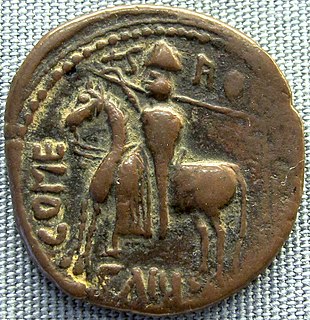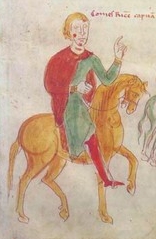The Val di Crati was an administrative region in the Kingdom of Sicily. It was the territory originally conquered by Robert Guiscard in the 1050s. At that time, its population was a mix of Greek and Lombard (Latin) Christians. [1] Under the Hohenstaufen and Angevin kings, the Val di Crati became closely associated with the terra iordanis, the land of Jordan (died 1092), son of Roger I. The terra iordanis retained its distinct identity into the 13th century. [2]

The Kingdom of Sicily was a state that existed in the south of the Italian peninsula and for a time the region of Ifriqiya from its founding by Roger II in 1130 until 1816. It was a successor state of the County of Sicily, which had been founded in 1071 during the Norman conquest of the southern peninsula. The island was divided into three regions: Val di Mazara, Val Demone and Val di Noto; 'val' being the Arabic word meaning 'district'.

Robert Guiscard was a Norman adventurer remembered for the conquest of southern Italy and Sicily. Robert was born into the Hauteville family in Normandy, went on to become Count of Apulia and Calabria (1057–1059), and then Duke of Apulia and Calabria and Duke of Sicily (1059–1085), and briefly Prince of Benevento (1078–1081) before returning the title to the Pope.

The Hohenstaufen, also known as Staufer, were a dynasty of German kings (1138–1254) during the Middle Ages. Before ascending to the kingship, they were Dukes of Swabia from 1079. As kings of Germany, they had a claim to Italy, Burgundy and the Holy Roman Empire. Three members of the dynasty—Frederick I (1155), Henry VI (1191) and Frederick II (1220)—were crowned emperor. Besides Germany, they also ruled the Kingdom of Sicily (1194–1268) and the Kingdom of Jerusalem (1225–1268)
In 1145, the first Cistercian monastery in southern Italy, Santa Maria della Sambucina, was founded in the Val di Crati. [3] In 1150, Roger II issued a new law (novella) for Calabria and the Val di Crati, instructing judges on how to divide property among heirs. [4] It had its own justiciar in 1150 and its own chamberlain (camerarius). [5]

Roger II was King of Sicily, son of Roger I of Sicily and successor to his brother Simon. He began his rule as Count of Sicily in 1105, became Duke of Apulia and Calabria in 1127, and then King of Sicily in 1130. By the time of his death at the age of 58, Roger had succeeded in uniting all the Norman conquests in Italy into one kingdom with a strong centralized government.
In Medieval England and Scotland the Chief Justiciar was roughly equivalent to a modern Prime Minister as the monarch's chief minister. Similar positions existed in Continental Europe, particularly in Norman Italy and in the Carolingian empire. The term is the English form of the medieval Latin justiciarius or justitiarius.

A chamberlain is a senior royal official in charge of managing a royal household. Historically, the chamberlain superintends the arrangement of domestic affairs and was often also charged with receiving and paying out money kept in the royal chamber. The position was usually honoured upon a high-ranking member of the nobility (nobleman) or the clergy, often a royal favourite. Roman emperors appointed this officer under the title of cubicularius. The papal chamberlain of the Pope enjoys very extensive powers, having the revenues of the papal household under his charge. As a sign of their dignity, they bore a key, which in the seventeenth century was often silvered, and actually fitted the door-locks of chamber rooms, since the eighteenth century it had turned into a merely symbolic, albeit splendid, rank-insignia of gilded bronze. In many countries there are ceremonial posts associated with the household of the sovereign.

Roger I, nicknamed Roger Bosso and The Great Count, was a Norman nobleman who became the first Count of Sicily from 1071 to 1101. He was a member of the House of Hauteville, and his descendants in the male line continued to rule Sicily down to 1194.

Adelaide del Vasto was countess of Sicily as the third spouse of Roger I of Sicily, and Queen consort of Jerusalem by marriage to Baldwin I of Jerusalem. She served as regent of Sicily during the minority of her son Roger II of Sicily from 1101 until 1112.

Alfonso, also called Anfuso or Anfusus, was the Prince of Capua from 1135 and Duke of Naples from 1139. He was an Italian-born Norman of the noble Hauteville family. After 1130, when his father Roger became King of Sicily, he was the third in line to the throne; second in line after the death of an older brother in 1138. He was the first Hauteville prince of Capua after his father conquered the principality from the rival Norman Drengot family. He was also the first Norman duke of Naples after the duchy fell vacant on the death of the last Greek duke. He also expanded his family's power northwards, claiming lands also claimed by the Papacy, although he was technically a vassal of the Pope for his principality of Capua.
Ranulf II was the count of Alife and Caiazzo, and duke of Apulia. He was a member of the Italo-Norman Drengot family which dominated the Principality of Capua for most of the century between 1050 and 1150. Ranulf's wife, Matilda, was the sister of King Roger II of Sicily.
Geoffrey or Godfrey was the second eldest son of Roger I of Sicily. He was probably a bastard, like his elder brother Jordan, but he may have been a legitimate son by either Judith of Évreux or Eremburga of Mortain. Either way, he stood no chance of inheriting, for he had leprosy, or some similar disease. He never married, but was engaged to a daughter of Boniface del Vasto.
Henry Aristippus of Calabria, sometimes known as Enericus or Henricus Aristippus, was a religious scholar and the archdeacon of Catania and later chief familiaris of the triumvirate of familiares who replaced the admiral Maio of Bari as chief functionaries of the kingdom of Sicily in 1161.

Richard, count of Acerra was an Italo-Norman nobleman, grandson of Robert of Medania, a Frenchman of Anjou. Brother of Sibylla, queen of Tancred of Sicily, Richard was the chief peninsular supporter of his brother-in-law during his claim for the throne in 1189.
Hugh was the Archbishop of Capua in the late 1140s and Archbishop of Palermo from 1150 until his death, probably in 1165/66.

Dipold, known in German as Diepold von Schweinspünt, was a German ministerialis who was raised to the Duchy of Spoleto in 1209. Of Bavarian origin, he was a reputed younger son of Berthold II of Vohburg and Adelaide of Ballenstedt. He was originally a vassal of the count of Lechsgemünd. His career in the Mezzogiorno was marked by continual raids and sieges, battles, and sacks recounted in exhaustive detail by Richard of San Germano, a monk of the abbey whose lands were especially hard hit.
Guarin was the chaplain and chancellor of Roger II of Sicily from about 1130 to his death, during the first decade of the Norman kingdom of Sicily. According to Alexander of Telese, the contemporary chronicler, he was "erudite ... and most prudent in negotiations ... a cleric well-versed in letters, skillful in matters of the world, and possessed of a tenacious and cautious mind."
Jocelyn was an Italo-Norman officer serving Roger II of Sicily.

The term Norman-Arab-Byzantine culture, Norman-Sicilian culture or, less inclusive, Norman-Arab culture, refers to the interaction of the Norman, Latin, Arab and Byzantine Greek cultures following the Norman conquest of Sicily and of Norman Africa from 1061 to around 1250. This civilization resulted from numerous exchanges in the cultural and scientific fields, based on the tolerance showed by the Normans towards the Greek-speaking populations and the Muslim settlers. As a result, Sicily under the Normans became a crossroad for the interaction between the Norman and Latin Catholic, Byzantine-Orthodox and Arab-Islamic cultures.

The Terra di Bari, in antiquity Peucetia and in the Middle Ages Ager Barianus, is the region around Bari in Apulia. Historically it was one of the justiciarships of the Kingdom of Sicily and later Naples. It became a province in the Two Sicilies. Today it is a part of the Province of Bari in Italy. Since 2005, according to the municipal government of Bari, it refers to the metropolitan area of the city and is trademarked for touristic purposes.
Fulco of Basacers was an Italo-Norman knight and landholder with considerable possessions in the Val di Crati in Calabria. The seat of his lordship was "Brahalla", a place or castle that no longer exists.

The County of Apulia and Calabria, later the Duchy of Apulia and Calabria, was a Norman country founded by William of Hauteville in 1042 in the territories of Gargano, Capitanata, Apulia, Vulture, and most of Campania. It became a duchy when Robert Guiscard was raised to the rank of duke by Pope Nicholas II in 1059.
Robert of Lauro was the Count of Caserta, a powerful nobleman and administrator in the Kingdom of Sicily, "effectively the king's viceroy on the mainland" between 1171 and his death. He was a close colleague of Count Tancred of Lecce, the future king. His influence helped his cousin Roger become Archbishop of Benevento (1179–1225).

Lombards of Sicily are an ethnolinguistic minority living in Sicily, southern Italy, speaking an isolated variety of Gallo-Italic dialects, the so-called Gallo-Italic of Sicily.

Val Demone or Val di Demona is a historical and geographical region encompassing the north-eastern third of Sicily. Historically, it was one of the three valli of Sicily.
Events during the year 1105 in Italy.














